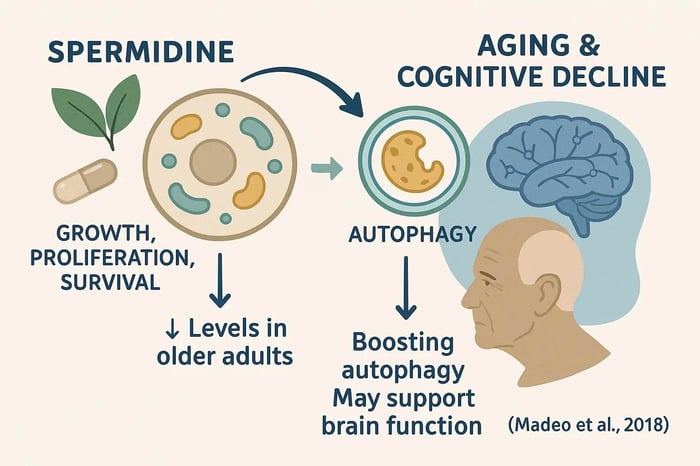Rapamycin Side Effects: Why Biohacker Bryan Johnson Stopped Taking It After 5 Years
By Anthony Loera | November 19, 2024
When renowned biohacker Bryan Johnson made the shocking announcement that he was discontinuing rapamycin side effects had forced him to end his five-year longevity experiment, it sent shockwaves through the anti-aging community. Johnson, famous for his ambitious "Project Blueprint" aimed at reversing biological aging, had become one of the most visible advocates for aggressive life extension protocols. His decision to stop taking rapamycin due to concerning side effects offers crucial insights for anyone considering this controversial anti-aging drug.
The story of Johnson's rapamycin journey reveals the complex reality behind longevity interventions that promise extended lifespan but may compromise healthspan. His experience highlights the critical importance of understanding rapamycin side effects before embarking on any anti-aging protocol involving this powerful immunosuppressive drug.
Table of Contents
- Ending a Five-Year Rapamycin Experiment
- Understanding Rapamycin Side Effects
- New Research: Accelerated Aging Concerns
- Community Response: Expert Opinions
- Implications for Longevity Research
- Conclusion: Prioritizing Health Over Longevity
- Final Thoughts
The End of Bryan Johnson's Rapamycin Experiment
On September 28th, Bryan Johnson made a pivotal announcement on X (formerly Twitter) that would reshape conversations about longevity interventions. After nearly five years of meticulous experimentation with rapamycin, Johnson decided to discontinue the drug due to persistent and concerning side effects.
"On September 28th, I decided to stop rapamycin, ending almost 5 years of experimentation with this molecule for its longevity potential."
Johnson's decision wasn't made lightly. Throughout his five-year journey, he had tested multiple dosing protocols in an attempt to optimize the longevity benefits while minimizing rapamycin side effects. His experimental approach included:
- Weekly doses of 5mg, 6mg, and 10mg
- Biweekly doses of 13mg
- Alternating weekly doses between 6mg and 13mg
- Various timing adjustments and cycling protocols
Despite his methodical approach and willingness to adjust dosages, the persistent side effects of rapamycin ultimately outweighed any potential longevity benefits. This decision marks a significant moment in the biohacking community, as Johnson has been one of the most prominent advocates for aggressive anti-aging interventions.
What Made Johnson's Experiment Unique
Johnson's approach to rapamycin experimentation was notably comprehensive. Unlike many individuals who might take rapamycin based on limited information, Johnson maintained detailed health monitoring throughout his experiment. This included regular blood work, continuous glucose monitoring, cardiovascular assessments, and comprehensive health tracking through his Blueprint protocol.
His systematic approach to documenting rapamycin side effects provides valuable real-world data that goes beyond laboratory studies. This transparency offers crucial insights for both researchers and individuals considering rapamycin for longevity purposes.
Understanding Rapamycin Side Effects: The Real-World Impact

Rapamycin, originally developed as an immunosuppressant to prevent organ transplant rejection, works by inhibiting the mTOR (mechanistic target of rapamycin) pathway. While this mechanism shows promise for extending lifespan in laboratory animals, the rapamycin side effects experienced by Johnson paint a concerning picture for human applications.
The side effects that ultimately led Johnson to discontinue rapamycin included:
Infection-Related Side Effects
Intermittent skin and soft tissue infections became a recurring problem for Johnson. As an immunosuppressant, rapamycin reduces the body's ability to fight off infections, making users more susceptible to bacterial, viral, and fungal infections. This side effect is particularly concerning for healthy individuals using rapamycin for longevity purposes, as it directly compromises quality of life.
Metabolic Disruptions
Lipid abnormalities emerged as another significant concern. Johnson observed changes in his lipid profile that could potentially increase cardiovascular risk over time. This ironic twist means that while rapamycin might theoretically extend lifespan, it could simultaneously increase the risk of heart disease.
Elevated glucose levels presented another metabolic challenge. Despite Johnson's otherwise optimized diet and lifestyle, rapamycin appeared to disrupt his glucose metabolism, potentially increasing diabetes risk.
Cardiovascular Effects
Increased resting heart rate was another troubling side effect. For someone as health-conscious as Johnson, this cardiovascular change was particularly concerning, especially given his comprehensive monitoring of heart health metrics.
Scientific Evidence Supporting Johnson's Experience
Johnson's observations align with extensive scientific literature documenting rapamycin side effects. Research has consistently identified several concerning areas:
Metabolic Complications
Disruption of Lipid Metabolism: Studies have shown that prolonged rapamycin use can adversely affect lipid profiles, potentially increasing cardiovascular risk rather than reducing it. This creates a paradoxical situation where a longevity intervention might actually harm heart health.
Insulin Resistance and Glucose Intolerance: Multiple studies have demonstrated that rapamycin can induce insulin resistance and elevate blood glucose levels. This effect appears to be dose-dependent and can persist even with dosing adjustments.
Pancreatic Concerns
Pancreatic Beta-Cell Toxicity: Research has revealed that rapamycin may be toxic to pancreatic beta cells, which are essential for insulin production. This finding is particularly alarming for long-term users, as it suggests potential for permanent metabolic damage.
Immune System Implications
Inhibition of Natural Killer Cells: While rapamycin's immunosuppressive effects might slow certain aspects of aging, they also compromise natural killer cells, which play crucial roles in cancer surveillance. This trade-off raises questions about whether rapamycin's benefits outweigh its risks.
Breakthrough Research: Does Rapamycin Actually Accelerate Aging?

Perhaps most shocking was the release of a preprint study on October 27th, just weeks after Johnson's announcement. This groundbreaking research suggested that rapamycin, along with several other supposed longevity interventions, might actually accelerate aging in humans when measured across 16 different epigenetic aging clocks.
This comprehensive evaluation challenges the fundamental assumptions underlying rapamycin's use as an anti-aging intervention. Previous studies that showed longevity benefits in mice may have overlooked crucial aspects of the aging process by focusing on limited biomarkers.
Understanding Epigenetic Aging Clocks
Epigenetic aging clocks measure biological age by analyzing DNA methylation patterns. Unlike chronological age, biological age reflects how well or poorly a person is aging at the cellular level. The fact that rapamycin appears to accelerate aging across multiple epigenetic clocks suggests its effects on human aging may be fundamentally different from its effects in laboratory animals.
This research provides scientific backing for Johnson's decision and raises serious questions about the wisdom of using rapamycin for longevity purposes in healthy individuals.
Expert Reactions: The Longevity Community Responds
Johnson's announcement sparked intense debate within the longevity and biohacking communities. Responses ranged from support for his decision to criticism of his experimental approach.
Chris Masterjohn's Perspective
Nutrition scientist Chris Masterjohn provided one of the most pointed critiques of rapamycin use for longevity:
"Rapamycin DESTROYS healthspan at the same time it promotes lifespan. Bryan's choice is wise. Lengthening lifespan in mice at the expense of fatty liver, high blood glucose, heart fibrosis, and testicular atrophy is a ridiculous basis to use for life extension in humans."
Masterjohn's assessment highlights a crucial distinction between lifespan and healthspan. Even if rapamycin could extend total lifespan, the quality of those additional years might be severely compromised by the drug's side effects.
The Healthspan vs. Lifespan Debate
Johnson's experience has intensified discussions about whether longevity interventions should prioritize extending total lifespan or maintaining quality of life. The emerging consensus suggests that interventions causing significant side effects may not represent true progress in anti-aging medicine.
Lessons from Animal Studies
While rapamycin extends lifespan in mice, these studies often overlook the quality of life implications. Mice receiving rapamycin in longevity studies frequently experience:
- Increased susceptibility to infections
- Metabolic dysfunction
- Reduced immune function
- Impaired wound healing
These effects mirror Johnson's experience and suggest that the animal model findings may not translate favorably to human applications.
Implications for the Future of Longevity Research
Johnson's experience with rapamycin side effects has profound implications for the broader field of longevity research and anti-aging medicine.
Rethinking Biomarkers and Study Design
The recent research suggesting rapamycin accelerates aging across multiple epigenetic clocks highlights the need for more comprehensive assessment methods in longevity research. Future studies should evaluate:
- Multiple aging biomarkers simultaneously
- Quality of life measures
- Comprehensive side effect profiles
- Long-term health outcomes
The Importance of N-of-1 Studies
Johnson's detailed self-experimentation provides valuable data that complements traditional clinical trials. His willingness to share both positive and negative results offers insights that might not emerge from conventional study designs.
Personalized Medicine Considerations
The variation in how individuals respond to rapamycin suggests that personalized approaches to longevity interventions may be necessary. Factors that might influence rapamycin side effects include:
- Genetic variations in drug metabolism
- Baseline health status
- Age and gender
- Concurrent medications and supplements
- Lifestyle factors
Alternative Approaches to Healthy Aging
Johnson's experience with rapamycin side effects doesn't diminish the potential for other longevity interventions. His decision to discontinue rapamycin has led him to focus more heavily on proven lifestyle interventions and safer supplementation strategies.
Evidence-Based Longevity Interventions
While rapamycin's side effects proved problematic, numerous other interventions show promise for healthy aging without significant adverse effects:
- Caloric restriction and intermittent fasting
- Regular exercise and strength training
- Stress management and sleep optimization
- Targeted nutritional supplementation
- Social connection and purpose cultivation
The Role of Lifestyle Medicine
Johnson's experience reinforces the importance of lifestyle-based approaches to longevity. While pharmaceutical interventions like rapamycin carry significant side effect risks, lifestyle modifications generally offer benefits with minimal downside.
Learning from Johnson's Transparency
One of the most valuable aspects of Johnson's rapamycin experiment is his commitment to transparency about both successes and failures. This openness provides crucial lessons for the longevity community.
The Value of Negative Results
In scientific research, negative results are often underreported, leading to publication bias that skews understanding of interventions' true risk-benefit profiles. Johnson's willingness to share his negative experience with rapamycin side effects provides valuable counterbalance to overly optimistic reports about the drug's potential.
Informed Consent and Risk Assessment
Johnson's experience highlights the importance of thorough risk assessment before beginning any experimental longevity intervention. Key considerations include:
- Comprehensive baseline health assessment
- Understanding potential side effects
- Establishing clear discontinuation criteria
- Regular monitoring and evaluation
- Professional medical oversight
Conclusion: Prioritizing Healthspan Over Lifespan
Bryan Johnson's decision to discontinue rapamycin after experiencing significant side effects represents a watershed moment in the longevity movement. His experience demonstrates that extending lifespan means nothing if it comes at the cost of quality of life and health.
The rapamycin side effects Johnson experienced serve as a crucial reminder that not all interventions showing promise in animal studies will translate safely or effectively to humans. The emerging research suggesting rapamycin may actually accelerate human aging further validates his decision to prioritize immediate health over theoretical longevity benefits.
Frequently Asked Questions About Rapamycin Side Effects
What are the most common rapamycin side effects?
The most common rapamycin side effects include increased infection risk, metabolic disruptions (elevated glucose and lipid abnormalities), cardiovascular changes (increased heart rate), immune suppression, and potential pancreatic toxicity. Bryan Johnson experienced skin infections, glucose elevation, and lipid problems during his 5-year experiment, which ultimately led to his decision to discontinue the drug.
Why did Bryan Johnson stop taking rapamycin?
Bryan Johnson stopped taking rapamycin after 5 years due to persistent side effects including intermittent skin and soft tissue infections, lipid abnormalities, elevated glucose levels, and increased resting heart rate. Despite trying various dosing protocols ranging from 5mg to 13mg in different schedules, these side effects continued, leading him to prioritize healthspan over potential longevity benefits.
Does rapamycin actually extend human lifespan?
While rapamycin extends lifespan in laboratory mice, recent research suggests it may actually accelerate aging in humans across 16 epigenetic aging clocks. The translation from animal studies to human applications appears problematic, with side effects potentially outweighing any longevity benefits. Johnson's experience supports this concerning finding.
Is rapamycin safe for healthy people to take?
Rapamycin carries significant side effect risks for healthy individuals, including immune suppression, metabolic dysfunction, and infection susceptibility. As an immunosuppressive drug originally designed for organ transplant patients, its risk-benefit profile for healthy longevity seekers is questionable, as clearly demonstrated by Johnson's comprehensive 5-year experiment.
What are the metabolic side effects of rapamycin?
Rapamycin can cause serious metabolic side effects including insulin resistance, elevated blood glucose, disrupted lipid metabolism, and potential pancreatic beta-cell toxicity. These effects can increase cardiovascular and diabetes risk, ironically contradicting the health goals that longevity interventions are supposed to achieve.
Are there safer alternatives to rapamycin for longevity?
Yes, significantly safer longevity approaches include caloric restriction, intermittent fasting, regular exercise, stress management, sleep optimization, and targeted nutritional supplementation. These evidence-based lifestyle interventions offer proven aging benefits without the significant side effect risks associated with rapamycin use.
How does rapamycin affect the immune system?
Rapamycin suppresses immune function, increasing infection risk and potentially inhibiting natural killer cells that are important for cancer surveillance. While this immunosuppression may slow some aging processes, it dangerously compromises the body's ability to fight off infections and diseases, as Johnson experienced firsthand.
What can we learn from Bryan Johnson's rapamycin experiment?
Johnson's experiment demonstrates the critical importance of prioritizing healthspan over lifespan, the value of comprehensive health monitoring during experimental interventions, the need for transparency about negative results in longevity research, and the sobering recognition that promising animal studies don't always translate safely to human applications.
The Future of Responsible Longevity Research
Johnson's transparent sharing of his rapamycin side effects experience contributes invaluable insights to the longevity research community. His willingness to admit when an intervention isn't working, despite significant time and resource investment, exemplifies the scientific integrity needed in this field.
The conversation around rapamycin and its side effects illustrates the dynamic and evolving nature of longevity research. As we continue to explore interventions that might extend healthy human lifespan, transparency, caution, and respect for individual health must remain paramount.
Johnson's experience serves as both a cautionary tale and an inspiring example of how to approach experimental longevity interventions responsibly. His commitment to sharing both successes and failures helps ensure that future longevity seekers can make more informed decisions about the risks and benefits of various anti-aging strategies.
Ultimately, the goal of longevity research should be to extend not just the quantity of life, but its quality. Johnson's decision to discontinue rapamycin in favor of safer alternatives represents a mature understanding of this principle and offers hope for more effective, safer longevity interventions in the future.
References:
- Johnson, B. Twitter/X announcement regarding rapamycin discontinuation, September 28, 2024
- Disruption of Lipid Metabolism - PubMed Study
- Insulin Resistance and Glucose Intolerance - NCBI PMC Study
- Pancreatic Beta-Cell Toxicity - Diabetes Journal Research
- Natural Killer Cell Inhibition - NCBI PMC Research
- Epigenetic Aging Clock Study - Preprint released October 27, 2024







